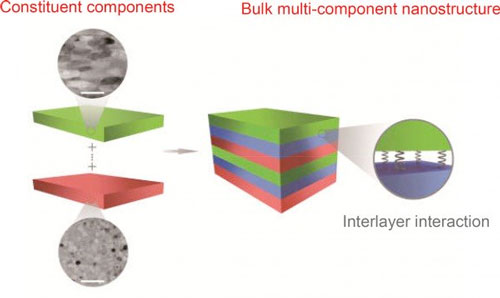| Posted: May 14, 2018 |
Precise control of bulk, multi-component nanostructures
(Nanowerk News) Researchers from Yanshan University have devised a new strategy, depicted here, that allows them to precisely design and construct bulk, multi-component nanomaterials with more complexity beyond previously reported methods.
|
|
Materials scientists have expected that multi-component nanostructures comprising three or more functional components would offer opportunities for creating new properties or integrating multiple functionalities in one system, through the interaction between the constituent components, which hold promise for electronics, energy-conversion and biotechnology applications.
|
|
However, creating such structures in a well-controlled way remains a formidable challenge, because of the desired structures of the constituents normally conflict with each other in bulk materials, such as the grain size, shape, volume fraction, and crystallographic orientation.
|
|
But now, using a novel strategy, researchers at Yanshan University (China) can precisely design and construct a bulk, multi-component nanostructure with the desired structures for each constituent component. Their findings make a breakthrough in controlled synthesis of bulk, multi-component nanomaterials.
|
|
This work was recently published in the journal Small ("Engineering Bulk, Layered, Multi-Component Nanostructures with High Energy Density").
|
 |
| (Image: Yanshan University)
|
|
“This strategy will enable the creation of bulk, multi-component nanostructure in a well-controlled way, which is not accessible to existing approaches,” said Xiangyi Zhang, a professor at the State Key Laboratory of Metastable Materials Science and Technology (Yanshan University, China), who devised the strategy and is the leader of metastable functional materials in the Lab.
|
|
Zhang and his colleagues use an assembly strategy to engineer bulk, multi-component nanostructures, in which layered subunits consisting of one or two nanoscale functional components are constructed and assembled into a bulk material. In contrast to previous approaches, this strategy enables researchers to separately manipulate conflicting constituents in separate layers; besides, each layer made up of one or two tunable components can act as building blocks to construct the required multi-component nanostructure. “This will enable simultaneous control over the structures of the constituent components,” Zhang said.
|
|
To illustrate the power of their approach, Zhang and his team have generated a technologically important bulk multi-component nanomaterial, (SmCo + FeCo)/NdFeB with the desired structures of the constituents, which cannot be realized with existing methods. The resulting nanostructure exhibits an record-high energy density for this class of bulk nanocomposites consisting of both hard and soft magnetic materials, with the soft magnetic fraction exceeding 20 wt%.
|
|
For the past two decades, the creation of such bulk nanocomposite magnets with the desired structure has been considered as an engineering nightmare. “But now we have overcome this challenge by devising the method,” Zhang said. “We expect that our design approach is not limited to a three-component system and will be extended to even more complex systems for exploring their new functionalities.”
|
|
Besides magnetic materials, this new strategy can also be applied to other nanostructured materials such as thermoelectric and mechanical materials to create hierarchical layered or heterogeneous nanostructures. Moreover, their method might also be used to generate more complex bulk hybrid nanomaterials through the assembly of the layers composed of, for example, thermoelectric, multiferroic and ferroelectric materials. Their findings therefore provide an exciting new direction for engineering bulk, complex, and hybrid nanostructures with novel functionalities.
|

